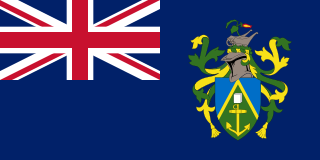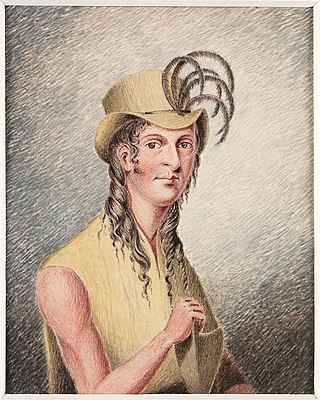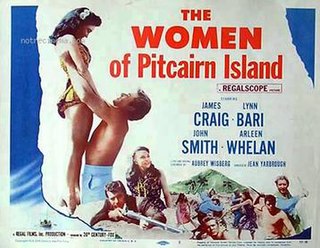
The Pitcairn Islands, officially Pitcairn, Henderson, Ducie and Oeno Islands, are a group of four volcanic islands in the southern Pacific Ocean that form the sole British Overseas Territory in the Pacific Ocean. The four islands—Pitcairn, Henderson, Ducie and Oeno—are scattered across several hundred miles of ocean and have a combined land area of about 18 square miles (47 km2). Henderson Island accounts for 86% of the land area, but only Pitcairn Island is inhabited. The inhabited islands nearest to the Pitcairn Islands are Mangareva, 688 km to the west, as well as Easter Island, 1,929 km to the east.

Adamstown is the capital of the Pitcairn Islands, and the only settlement on the Pitcairn Islands, the only British Overseas Territory that is located in the southern Pacific Ocean.

The history of the Pitcairn Islands begins with the colonization of the islands by Polynesians in the 11th century. Polynesian people established a culture that flourished for four centuries and then vanished. They lived on Pitcairn and Henderson Islands, and on Mangareva Island 540 kilometres (340 mi) to the northwest, for about 400 years.

Fletcher Christian was an English sailor who led the mutiny on the Bounty in 1789, during which he seized command of the Royal Navy vessel HMS Bounty from Lieutenant William Bligh.

George Hunn Nobbs baptised George Hunn was an English missionary on Pitcairn Island and later Norfolk Island, where many of his descendants still live today.

The descendants of the Bounty mutineers include the modern-day Pitcairn Islanders as well as a little less than half of the population of Norfolk Island. Their common ancestors were the nine surviving mutineers from the mutiny on HMS Bounty which occurred in the south Pacific Ocean in 1789. Their descendants also live in New Zealand, Australia, and the United States.
Pitcairn Islanders, also referred to as Pitkerners and Pitcairnese, are the native inhabitants of the Pitcairn Islands, a British Overseas Territory including people whose families were previously inhabitants and maintaining cultural connections. Most Pitcairn Islanders are descendants of the Bounty mutineers.
Charles Richard Parkin Christian was a long-serving politician from Pitcairn. He was the Chief Magistrate of Pitcairn Island for eleven years at various times between 1920 and 1957. As is commonly the case with the small population of Pitcairn, he was closely related to several other island leaders, notably cousins Edgar Allen Christian, Frederick Martin Christian, and Gerard Bromley Robert Christian. He was also the grandson of Thursday October Christian II and uncle of Ivan Christian and Warren Clive Christian. Christian was born on Pitcairn, and died in Auckland, New Zealand.
Gerard Bromley Robert Christian served as Magistrate of the British Overseas Territory of Pitcairn Island from 1910 to 1919. As is commonly the case with the small population of Pitcairn, he was closely related to several other island leaders, notably cousins Edgar Allen Christian, Frederick Martin Christian, and Charles Richard Parkin Christian. He was also the grandson of Thursday October Christian II and was the father of John Lorenzo Christian. He was born and died on Pitcairn Island.
Ivan Roa Christian was a politician from Pitcairn. He was the Chief Magistrate of Pitcairn Island from 1976 to 1984. As his surname suggests, he is descended from the original mutineers who settled the island, led by Fletcher Christian. He is related to a number of other island leaders, including his father Richard Edgar Christian, his uncle Charles Richard Parkin Christian and his great-grandfather Thursday October Christian II. Through his marriage to Verna Young, he is the father of Steve Christian and Brenda Christian.
Edgar Allen Christian was a politician from Pitcairn Island. He served as Chief Magistrate in 1923, 1924 and 1932. As is commonly the case with the small population of Pitcairn, he was closely related to several other island leaders, notably brother Frederick Martin Christian, cousins Gerard Bromley Robert Christian and Charles Richard Parkin Christian, and grandfather Thursday October Christian II.
Frederick Martin "Fred" Christian was a politician from Pitcairn. He was the Chief Magistrate of Pitcairn Island on three occasions between 1921 and 1943, and was a Pitcairn councillor in 1956.

Thursday October Christian was the first son of Fletcher Christian and his Tahitian wife Mauatua. He was the first child born on the Pitcairn Islands after the mutineers took refuge on the island. Born on a Thursday in October, he was given his unusual name because Fletcher Christian wanted his son to have "no name that will remind me of England."

George Adams was the only son of the Bounty Mutineer John Adams. He was born to his wife Teio, who had once been the wife of William McCoy and was the mother-in-law of Charles Christian, on Pitcairn Island. Adams was born at a time when all the original mutineers apart from his own father had been killed or, in the case of Ned Young, died of natural causes. In 1808 the Pitcairn colony was discovered and the elder Adams was granted amnesty for his part in the mutiny. Both of Adams's parents died in March 1829, when George was 24 years old. Adams served as Chief Magistrate on Pitcairn in 1848. Adams was an opponent of Joshua Hill in the 1830s. Adams opposed the decision to move to Norfolk Island in the 1850s, as his granddaughter was ill. Adams did eventually move, and died on Norfolk Island in 1873.
Simon Young served as Magistrate of the British colony of the Pitcairn Islands in 1849. Young was the son of George Young, who in turn was the son of Bounty mutineer Ned Young, his mother was Hannah Adams, a daughter of John Adams. Young married Mary Buffett Christian, his father-in-law John Buffett had arrived on the island in 1823 as a schoolteacher, and had stayed to help Adams teach the islands many children. Young himself was a schoolteacher by trade. He spent several years on Norfolk Island but returned to Pitcairn in 1864. Young's marriage produced 13 children, including two future Magistrates, Benjamin Stanley Young, William Alfred Young and Arthur Herbert Young, and the historian Rosalind Amelia Young.

The Women of Pitcairn Island is a 1956 American adventure drama film directed by Jean Yarbrough and starring Lynn Bari, John Smith and Sue England. It was produced by Robert L. Lippert Regal Films for distribution by 20th Century Fox. The film's sets were designed by the art director Dave Milton.
Rosalind Amelia Young was an historian from Pitcairn Islands.
Norfolk Islanders, also referred to as just Islanders, are the inhabitants or residents of Norfolk Island, an external territory of Australia. The Islanders have their own unique identity and are predominantly people of Pitcairn and English descent and to a lesser extent of Scottish and Irish.

Teraura, also Susan or Susannah Young, was a Tahitian woman who settled on Pitcairn Island with the Bounty Mutineers. She took part in Ned Young's plot to murder male Polynesians who had travelled on HMS Bounty and killed Tetahiti. A tapa maker, examples of her craft are found in the British Museum and at Kew Gardens.

Mauatua, also Maimiti or Isabella Christian, also known as Mainmast, was a Tahitian tapa maker, who settled on Pitcairn Island with the Bounty mutineers. She married both Fletcher Christian and Ned Young, and had children with both men. Fine white tapa, which was her specialty, is held in the collections of the British Museum and the Pitt Rivers Museum, amongst others.









